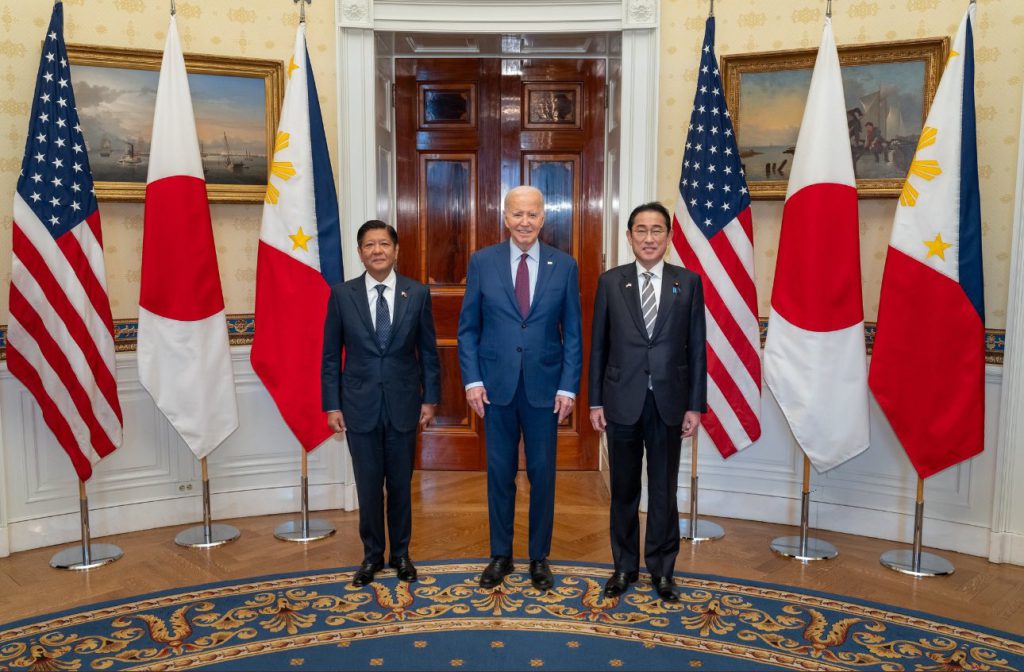US, Japan strengthen alliance with Philippines
Philippine President Ferdinand Marcos Jr., US President Joseph Biden and Japanese Prime Minister Fumio Kishida met in Washington for the first trilateral summit last April 11, 2024. Photo from Presidential Communications Office.
By Manuel Mogato | Date 04-15-2024
MANILA — President Ferdinand Marcos Jr. has returned home from a trilateral summit with the United States and Japan in Washington, brimming with billions of dollars of defense and economic investments.
The investment pledges are designed to strengthen the Philippines’ minimum credible defenses in the face of China’s increasing coercive activities in the South China Sea.
“I think the trilateral agreement is extremely important,” Marcos said in a news conference, a day after meeting President Joe Biden and Japanese Prime Minister Fumio Kishida in Washington.
“It is going to change the dynamic that we see in the region, in ASEAN in Asia, around the South China Sea.”
Marcos referred to a 10-nation bloc in Southeast Asia, which has remained divided in supporting China and the United States. ASEAN has remained muted in Chinese harassment of Philippine supply vessels.
In a strong reaction to the trilateral summit, Chinese Coast Guard and militia vessels swarmed Scarborough Shoal and some Philippine-occupied features in the Spratly.
During the trilateral summit, Biden announced $109 million funding for 23 construction projects in seven of nine local military bases where US forces were allowed access.
Biden said he had requested that US Congress allocate an additional $128 million in fiscal year 2025 to build airfields, ports, barracks, and warehouses in the locations.
The US military planned to pre-position more equipment and supplies for maritime security and humanitarian assistance and disaster relief (HADR) operations in these Enhanced Defense Cooperation Agreement (EDCA) sites.
Biden and Kishida also pledged to increase the frequency of holding naval and Coast Guard drills and training activities in the disputed West Philippine Sea.
More joint sail and air patrols would be conducted in the Philippines’ sovereign waters, challenging China’s illegal nine or ten-dash-line claims.
In a trilateral meeting among the three allies’ foreign, defense, and national security ministers, they agreed to upgrade the Philippine military capabilities, promising an unspecified number of equipment transfers under the US Foreign Military Financing (FMF) program and in the Japanese Official Security Assistance (OSA).
The Philippines needed to upgrade its coastal defense, long-range fires, integrated missile defenses, armed and unarmed drones, and maritime security tools.
On the economic front, the US and Japan had agreed to combine their resources to build a growth corridor from Batangas to Clark and Subic freeports.
They would construct highways, rails, ports, airports, and semiconductor families.
Philippine ambassador to the US, Jose Manuel Romualdez, said some $100 billion in investments were expected in the next 5-10 years in clean energy and renewables, critical minerals and supply chain resilience, connectivity, and digital economy.
There were pledges in agriculture, telecommunications, and space industry.
“This whole cooperation is critical to our collective security and continued prosperity across the region,” US administration officials said after the historic trilateral summit.
A Chinese Coast Guard vessel also intercepted a Philippine maritime survey vessel and its Coast Guard escort just 35 nautical miles off the Pangasinan coastline.
Chinese ships have been harassing the Philippines’ resupply missions in Ayungin Shoal, using water cannons and ramming the vessels.
Beijing also had summoned Manila’s ambassador to China and a Japanese embassy official to oppose what its foreign ministry described as “negative comments” against China.
Also, in Washington, two US lawmakers filed an urgent measure to grant $500 million a year for the next five years to help the Philippines develop a minimum credible defense posture.
The measure, the Philippines’ Enhanced Resilience Act of 2024 (PERA), had a higher chance of getting approved because it has bipartisan support.
It would approve equipment transfers under the US State Department’s foreign military financing (FMF) program.
Since 2015, the Philippines has received $1.14 billion in military equipment, like planes, ships, small arms, drones, communications and mobility.

